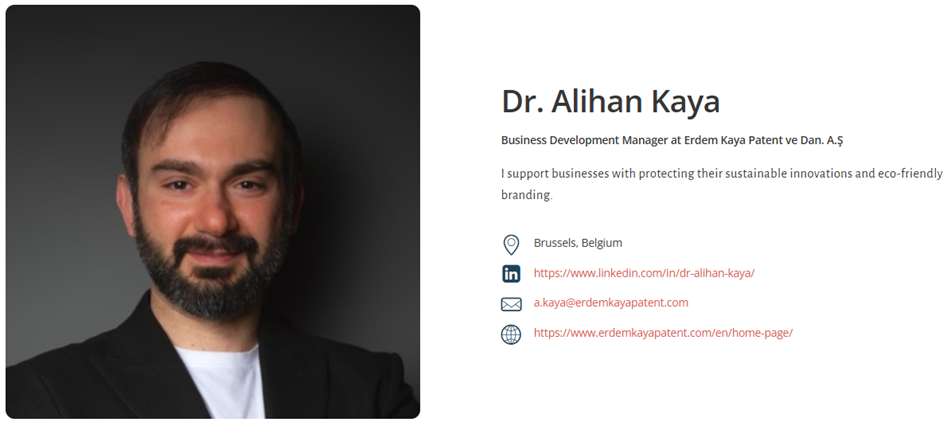Alihan Kaya is Subject Matter Expert in the CEIPI-EPO Master of IP Law and Management
The journey from concept to market-ready product is fraught with challenges, particularly in industries where technological evolution and sustainability demands collide. Companies must balance innovation👉 Practical application of new ideas to create value. with practicality, protect intellectual property👉 Creations of the mind protected by legal rights. (IP) in crowded markets, and align product strategies with environmental goals. This blog post is a summary of the third module of the CEIPI-EPO Master’s Program in IP Law and Management (MIPLM) on the topic of the Emergence of Dominant Designs. An overview of this lecture is available here:
It explores the complexities of managing product development and dominant designs, the unique IP hurdles in sustainable innovation, and how Alihan Kaya’s methodology offers a blueprint for integrating sustainability into product lifecycle management. Alihan Kaya is a Subject Matter Expert for sustainable IP at the CEIPI-EPO MIPLM.
The Crossroads of Product Development and Dominant Designs
Product development is a high-stakes balancing act. Firms must innovate rapidly while anticipating market shifts, technological disruptions, and the emergence of dominant designs—standards that reshape industries.
Technological Uncertainty and Market Readiness
Early-stage markets, like the personal digital assistant (PDA) industry in the 1990s, illustrate the risks of premature entry. Apple’s Newton, launched in 1993, struggled due to immature enabling technologies (e.g., batteries, handwriting recognition) and ambiguous market positioning. Conversely, Palm’s later entry with a simplified, affordable design captured 77% market share by 1999. The lesson? Timing is critical. Companies must assess whether enabling technologies are mature enough to support their vision and whether customers are ready to adopt.
Dominant designs amplify these challenges. Consider the QWERTY keyboard: while not the most ergonomic layout, its early adoption created entrenched user habits and production ecosystems. Similarly, VHS’s victory over Betamax was less about technical superiority and more about strategic licensing👉 Permission to use a right or asset granted by its owner. to the adult entertainment industry. Once a dominant design👉 A dominant design is a widely accepted standard within an industry. emerges, industries shift from fluid experimentation to incremental improvements, often sidelining radical innovators.
The Innovator’s Dilemma and Cross-Functional Friction
Established firms face the “innovator’s dilemma,” where focus on current customer needs blinds them to disruptive threats. Motorola’s delay in transitioning from analog to digital mobile technology allowed Nokia to dominate. Internally, misalignment between R&D, marketing, and legal teams exacerbates risks. For example, engineers prioritizing technical perfection may clash with marketing’s push for rapid launches. The stage-gate process, used by companies like Exxon, mitigates this by embedding cross-functional checkpoints, but siloed departments can still derail progress.
Network Externalities and Lock-In Effects
Dominant designs thrive on network externalities—the more users adopt a technology, the more valuable it becomes. Microsoft’s Windows OS and Sony’s PlayStation leveraged complementary ecosystems (software, games) to entrench their positions. However, this creates lock-in, making it difficult for successors to displace incumbents. For instance, transitioning from fossil fuel vehicles to electric mobility requires rebuilding supply chains and consumer habits, a challenge automakers like Toyota addressed early with the Prius.
👉 https://ip-management-voice.podigee.io/24-alihan-kaya-patenting-sustainable-technologies
👉 https://ipbusinessacademy.org/the-changing-role-of-ip-in-business-eco-systems-case-study-signify
IP Management Challenges in Sustainable Product Innovation
Sustainable products—designed for recyclability, energy efficiency, or reduced carbon footprints—introduce unique IP complexities. Protecting these innovations while fostering industry-wide adoption requires nuanced strategies.
Patent👉 A legal right granting exclusive control over an invention for a limited time. Thickets and Freedom-to-Operate (FTO) Risks
In sectors like clean energy or electric vehicles, overlapping patents create dense “thickets.” Siemens’ 3D navigation system faced costly redesigns due to rival patents, a scenario common in sustainability-driven industries. Conducting FTO analyses is resource-intensive, particularly for startups lacking legal bandwidth. For example, green tech👉 Eco-friendly innovations to reduce environmental impact and promote sustainability. firms may inadvertently infringe on battery or solar panel patents, delaying launches and inflating costs.
Balancing Disclosure and Protection
Patents require disclosing technical details, which competitors can exploit. Nokia’s strategic patenting in the 1990s protected core innovations without overexposure, but sustainable products often demand collaboration. Tesla’s decision to open some EV patents accelerated industry adoption but required careful retention of key IP. Startups risk👉 The probability of adverse outcomes due to uncertainty in future events. either over-patenting trivial features (wasting resources) or under-protecting critical tech (exposing vulnerabilities).
Global Fragmentation and Lifecycle Management
Patent laws vary widely—software patents eligible in the U.S. may fail in Europe. Sustainable products, like modular smartphones or biodegradable packaging, require multi-jurisdictional strategies. Kodak’s decline, partly due to poor digital imaging patent lifecycle management, underscores the risks of misaligned IP strategies. For sustainable innovations, decisions on renewing, abandoning, or licensing patents must align with environmental goals. IBM’s $27 billion annual licensing revenue shows the potential of strategic IP monetization, but green tech firms may prioritize broad adoption over profits, complicating revenue models.
Design Rights and Consumer Perception
Sustainable products often rely on aesthetic appeal (e.g., eco-friendly packaging) and functional design (e.g., modular architecture). Design rights protect these elements, but consumer demand for “green” branding invites copycats. For instance, Patagonia’s trade dress—distinctive eco-friendly branding—helps differentiate its products in a crowded market.
Alihan Kaya’s Framework: Embedding Sustainability into Product Development
Alihan Kaya’s methodology transforms sustainability from a compliance checkbox into a strategic asset, integrating IP management👉 Strategic and operative handling of IP to maximize value. with product development cycles.
Milestone-Based IP and Sustainability Integration
The approach can apply Exxon’s stage-gate process, but with sustainability checkpoints. During the scoping phase, teams identify environmental impact metrics (e.g., carbon footprint, recyclability). At each subsequent gate—business case development, technical design, testing—IP strategies are aligned with sustainability goals. For example, a firm developing a solar-powered sensor might patent novel energy-harvesting circuits while open-sourcing compatibility standards to foster industry adoption.
Case Study: Signify’s Circular Lighting
As Philips Lighting, Signify faced challenges in transitioning from linear sales (light bulbs) to circular models (lighting-as-a-service). A sustainability framework guided the redesign of products for modularity and recyclability. Patents protected proprietary LED drivers, while design rights ensured sleek, recognizable fixtures. Trade secrets guarded manufacturing processes for rare-earth-free components. By licensing modular designs to competitors, Signify expanded its ecosystem without sacrificing IP control.
White Space Analysis and Collaborative Innovation
A modern sustainability framework also employs AI-driven patent landscaping to identify underdeveloped areas (“white spaces”) in sustainable tech. For instance, analyzing green hydrogen patents revealed opportunities in corrosion-resistant electrolyzers. Cross-industry workshops then align stakeholders—engineers, suppliers, regulators—on shared IP priorities. A medical device startup used this method to patent a biodegradable polymer while collaborating with NGOs on compostability standards.
Dynamic Portfolio Management👉 Strategic management of diverse assets to optimize returns and balance risk.
Sustainable innovations often have shorter lifespans due to rapid tech advancements. Predictive analytics evaluate patent viability against market trends. A wind turbine manufacturer, for example, abandoned outdated blade designs early, reallocating resources to modular turbines. Licensing older patents to developing nations generated revenue while advancing global sustainability goals.
Conclusion
Managing product development in the age of sustainability requires navigating dominant designs, IP complexities, and environmental imperatives. Alihan Kaya’s methodology exemplifies how integrating IP strategy👉 Approach to manage, protect, and leverage IP assets. with sustainability can turn constraints into opportunities. By embedding eco-consciousness into every development phase—from scoping to launch—companies can protect innovations, foster collaboration, and lead markets where others see only challenges. As industries evolve, those mastering this synergy will not only survive but thrive, proving that sustainability and profitability are not mutually exclusive but mutually reinforcing.
Subject expert
 Visit my expert profile on the digital IP lexicon 👉 🔗𝗱𝗜𝗣𝗹𝗲𝘅
Visit my expert profile on the digital IP lexicon 👉 🔗𝗱𝗜𝗣𝗹𝗲𝘅
